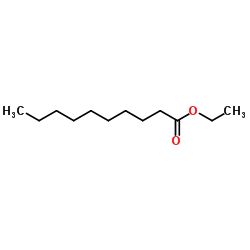Ethyl caprate

Ethyl caprate structure
|
Common Name | Ethyl caprate | ||
|---|---|---|---|---|
| CAS Number | 110-38-3 | Molecular Weight | 200.318 | |
| Density | 0.9±0.1 g/cm3 | Boiling Point | 242.5±3.0 °C at 760 mmHg | |
| Molecular Formula | C12H24O2 | Melting Point | -20°C | |
| MSDS | Chinese USA | Flash Point | 102.2±0.0 °C | |
|
Combined effects of nutrients and temperature on the production of fermentative aromas by Saccharomyces cerevisiae during wine fermentation.
Appl. Microbiol. Biotechnol. 99(5) , 2291-304, (2015) Volatile compounds produced by yeast during fermentation greatly influence the organoleptic qualities of wine. We developed a model to predict the combined effects of initial nitrogen and phytosterol content and fermentation temperature on the production of v... |
|
|
Volatile Compounds from Grape Skin, Juice and Wine from Five Interspecific Hybrid Grape Cultivars Grown in Québec (Canada) for Wine Production.
Molecules 20 , 10980-1016, (2015) Developed from crosses between Vitis vinifera and North American Vitis species, interspecific hybrid grape varieties are becoming economically significant in northern areas, where they are now extensively grown for wine production. However, the varietal diffe... |
|
|
Lecithin-linker formulations for self-emulsifying delivery of nutraceuticals.
Int. J. Pharm. 471(1-2) , 92-102, (2014) Lecithin-linker microemulsions are formulations produced with soybean lecithin in combination with a highly lipophilic (lipophilic linker) and highly hydrophilic (hydrophilic linkers) surfactant-like additives. In this work, lecithin-linker systems were formu... |
|
|
Characterization of Volatile Flavor Compounds in Chinese Rice Wine Fermented from Enzymatic Extruded Rice.
J. Food Sci. 80 , C1476-89, (2015) Enzymatic extrusion, instead of traditional steam cooking, to treat rice is an efficient and alternative pretreatment for Chinese rice wine fermentation. In order to determine the formation of volatiles in enzymatic extrusion-processed rice wine (EE), and to ... |
|
|
Dynamic transcriptome analysis and volatile profiling of Gossypium hirsutum in response to the cotton bollworm Helicoverpa armigera.
Sci. Rep. 5 , 11867, (2015) In response to insect herbivory, plants emit elevated levels of volatile organic compounds for direct and indirect resistance. However, little is known about the molecular and genomic basis of defense response that insect herbivory trigger in cotton plants an... |
|
|
Does Enzymatic Hydrolysis of Glycosidically Bound Volatile Compounds Really Contribute to the Formation of Volatile Compounds During the Oolong Tea Manufacturing Process?
J. Agric. Food Chem. 63 , 6905-14, (2015) It was generally thought that aroma of oolong tea resulted from hydrolysis of glycosidically bound volatiles (GBVs). In this study, most GBVs showed no reduction during the oolong tea manufacturing process. β-Glycosidases either at protein or gene level were ... |
|
|
Apple Aminoacid Profile and Yeast Strains in the Formation of Fusel Alcohols and Esters in Cider Production.
J. Food Sci. 80 , C1170-7, (2015) The amino acid profile in dessert apple must and its effect on the synthesis of fusel alcohols and esters in cider were established by instrumental analysis. The amino acid profile was performed in nine apple musts. Two apple musts with high (>150 mg/L) and l... |
|
|
Vehicle effects on in vitro percutaneous absorption through rat and human skin.
Pharm. Res. 11(10) , 1396-400, (1994) We studied the effects of three vehicles (propylene glycol, octanol and ethyl decanoate) with differing polarity on the in vitro percutaneous absorption of three chemicals (fluazifop-butyl, dimethyl phthalate and fomesafen sodium salt) with a range of physico... |
|
|
Influence of fatty acids on wine foaming.
J. Agric. Food Chem. 50(24) , 7042-5, (2002) The influence of fatty acids (free and bound as ethyl esters) on wine foaming was studied in different white wines and the corresponding sparkling wines. Moreover, from three of these wines the foam formed by CO(2) injection was separated, and two fractions w... |
|
|
Role of Yersinia intermedia and Pseudomonas putida in the development of a fruity off-flavour in pasteurized milk.
J. Dairy Res. 67(4) , 561-9, (2000) Analysis by gas chromatography-mass spectrometry of pasteurized milk with a fruity (pineapple like) off odour and a sour, rancid and soapy taste indicated the presence of concentrations at microg/ml levels of ethyl butanoate, ethyl hexanoate, ethyl octanoate,... |